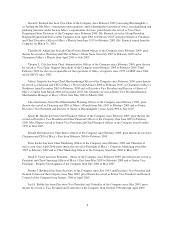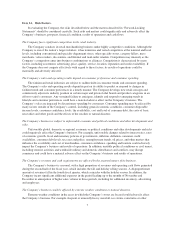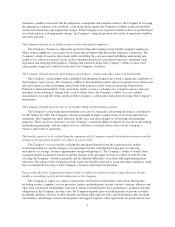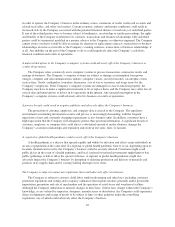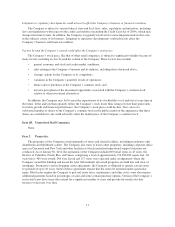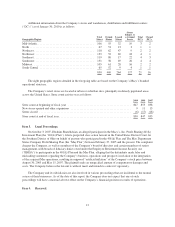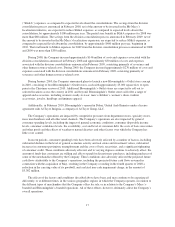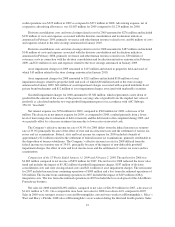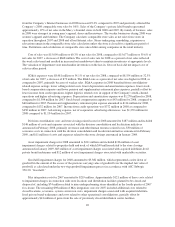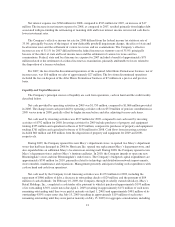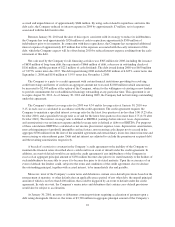Macy's 2009 Annual Report Download - page 22
Download and view the complete annual report
Please find page 22 of the 2009 Macy's annual report below. You can navigate through the pages in the report by either clicking on the pages listed below, or by using the keyword search tool below to find specific information within the annual report.Item 7. Management’s Discussion and Analysis of Financial Condition and Results of Operations.
The Company is a retail organization operating retail stores and Internet websites under two brands (Macy’s
and Bloomingdale’s) that sell a wide range of merchandise, including men’s, women’s and children’s apparel and
accessories, cosmetics, home furnishings and other consumer goods in 45 states, the District of Columbia, Guam
and Puerto Rico. As of January 30, 2010, the Company’s operations were conducted through four retail operating
divisions – Macy’s, macys.com, Bloomingdale’s, and bloomingdales.com – which are aggregated into one
reporting segment in accordance with the Financial Accounting Standards Board (“FASB”) Accounting
Standards Codification (“ASC”) Topic 280, “Segment Reporting.”
The Company continues to be focused on four key priorities for improving the business over the longer
term: (i) differentiating merchandise assortments and tailoring them to local tastes; (ii) delivering obvious value;
(iii) improving the overall shopping environment; and (iv) enhancing customer engagement, loyalty and traffic
through more brand focused and effective marketing.
On August 30, 2005, the Company completed the acquisition of The May Department Stores Company
(“May”) by means of a merger of May with and into a wholly-owned subsidiary of the Company (the “Merger”).
The Company added about 400 Macy’s locations nationwide in 2006 as it converted the regional department
store nameplates acquired through the Merger. In connection with the conversion process, the Company
identified certain store locations and distribution center facilities to be divested, and also announced its intention
to dispose of the acquired Lord & Taylor division and the acquired bridal group business, which included the
operations of David’s Bridal, After Hours Formalwear and Priscilla of Boston. The sale of the Lord & Taylor
division was completed in October 2006, the sale of David’s Bridal and Priscilla of Boston was completed in
January 2007 and the sale of After Hours Formalwear was completed in April 2007. As a result of the
Company’s disposition of the Lord & Taylor division and bridal group businesses, these businesses were
reported as discontinued operations. Unless otherwise indicated, the following discussion relates to the
Company’s continuing operations.
In February 2008, the Company announced a new initiative to strengthen local market focus and enhance
selling service in an effort to both accelerate same-store sales growth and reduce expense. The localization
initiative, called “My Macy’s,” was developed with the goal to accelerate sales growth in existing locations by
ensuring that core customers surrounding each Macy’s store find merchandise assortments, size ranges,
marketing programs and shopping experiences that are custom-tailored to their needs. To maximize the results
from My Macy’s, the Company has taken action in certain markets that: concentrate more management talent in
local markets, effectively reducing the “span of control” over local stores; create new positions in the field to
work with division planning and buying executives in helping to understand and act on the merchandise needs of
local customers; and empower locally based executives to make more and better decisions. In combination with
the localization initiative, the Company consolidated the Minneapolis-based Macy’s North organization into New
York-based Macy’s East, the St. Louis-based Macy’s Midwest organization into Atlanta-based Macy’s South and
the Seattle-based Macy’s Northwest organization into San Francisco-based Macy’s West. The Atlanta-based
division was renamed Macy’s Central. Sales performance in 2009 was strongest in the initial My Macy’s
markets.
In February 2009, the Company announced the expansion of the My Macy’s localization initiative across
the country. As My Macy’s was rolled out nationally to new local markets, the Company’s Macy’s branded
stores have been reorganized into a unified operating structure to support the Macy’s business. Division central
office organizations have been eliminated in New York-based Macy’s East, San Francisco-based Macy’s West,
Atlanta-based Macy’s Central and Miami-based Macy’s Florida. This has reduced central office and
administrative expense, eliminated duplication, sharpened execution, and helped the Company to partner more
effectively with its suppliers and business partners.
The savings from the division consolidation process, net of the amount to be invested in the My Macy’s
localization initiatives, have reduced, and are expected to continue to reduce, selling, general and administrative
16


